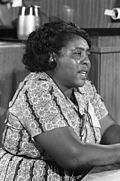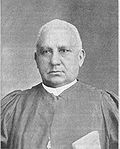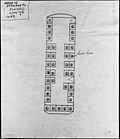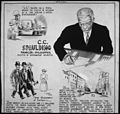Portal:Civil rights movement
The civil rights movement portal The civil rights movement was a social movement in the United States from 1954 to 1968 which aimed to abolish legalized racial segregation, discrimination, and disenfranchisement in the country, which most commonly affected African Americans. The movement had origins in the Reconstruction era in the late 19th century, and modern roots in the 1940s. After years of nonviolent protests and civil disobedience campaigns, the civil rights movement achieved many of its legislative goals in the 1960s, during which it secured new protections in federal law for the civil rights of all Americans. Following the American Civil War (1861–1865), the three Reconstruction Amendments to the U.S. Constitution abolished slavery and granted citizenship to all African Americans, the majority of whom had recently been enslaved in the southern states. During Reconstruction, African-American men in the South voted and held political office, but after 1877 they were increasingly deprived of civil rights under racist Jim Crow laws (which for example banned interracial marriage, introduced literacy tests for voters, and segregated schools) and were subjected to violence from white supremacists during the nadir of American race relations. African Americans who moved to the North in order to improve their prospects in the Great Migration also faced barriers in employment and housing. Legal racial discrimination was upheld by the Supreme Court in its 1896 decision in Plessy v. Ferguson, which established the doctrine of "separate but equal". The movement for civil rights, led by figures such as W. E. B. Du Bois and Booker T. Washington, achieved few gains until after World War II. In 1948, President Harry S. Truman issued an executive order abolishing discrimination in the armed forces. In 1954, the Supreme Court struck down state laws establishing racial segregation in public schools in Brown v. Board of Education. A mass movement for civil rights, led by Martin Luther King Jr. and others, began a campaign of nonviolent protests and civil disobedience including the Montgomery bus boycott in 1955–1956, "sit-ins" in Greensboro and Nashville in 1960, the Birmingham campaign in 1963, and a march from Selma to Montgomery in 1965. Press coverage of events such as the lynching of Emmett Till in 1955 and the use of fire hoses and dogs against protesters in Birmingham increased public support for the civil rights movement. In 1963, about 250,000 people participated in the March on Washington, after which President John F. Kennedy asked Congress to pass civil rights legislation. Kennedy's successor, Lyndon B. Johnson, overcame the opposition of southern politicians to pass three major laws: the Civil Rights Act of 1964, which prohibited discrimination based on race, color, religion, sex, or national origin in public accommodations, employment, and federally assisted programs; the Voting Rights Act of 1965, which outlawed discriminatory voting laws and authorized federal oversight of election law in areas with a history of voter suppression; and the Fair Housing Act of 1968, which banned housing discrimination. The Supreme Court made further pro–civil rights rulings in cases including Browder v. Gayle (1956) and Loving v. Virginia (1967), banning segregation in public transport and striking down laws against interracial marriage. (Full article...) Selected article -The Autobiography of Malcolm X is an autobiography written by American minister Malcolm X in collaboration with American journalist Alex Haley. It was released posthumously on October 29, 1965, nine months after his assassination. Haley coauthored the autobiography based on a series of in-depth interviews he conducted between 1963 and 1965. The Autobiography is a spiritual conversion narrative that outlines Malcolm X's philosophy of black pride, black nationalism, and pan-Africanism. After the leader was killed, Haley wrote the book's epilogue. He described their collaborative process and the events at the end of Malcolm X's life. While Malcolm X and scholars contemporary to the book's publication regarded Haley as the book's ghostwriter, modern scholars tend to regard him as an essential collaborator who intentionally muted his authorial voice to create the effect of Malcolm X speaking directly to readers. Haley influenced some of Malcolm X's literary choices. For example, Malcolm X left the Nation of Islam during the period when he was working on the book with Haley. Rather than rewriting earlier chapters as a polemic against the Nation which Malcolm X had rejected, Haley persuaded him to favor a style of "suspense and drama". According to Manning Marable, "Haley was particularly worried about what he viewed as Malcolm X's anti-Semitism" and he rewrote material to eliminate it. When the Autobiography was published, The New York Times reviewer Eliot Fremont-Smith described it as a "brilliant, painful, important book". In 1967, historian John William Ward wrote that it would become a classic American autobiography. In 1998, Time named The Autobiography of Malcolm X as one of ten "required reading" nonfiction books. James Baldwin and Arnold Perl adapted the book as a screenplay, which later provided the source material for Spike Lee's 1992 film Malcolm X. (Full article...) General imagesThe following are images from various civil rights movement-related articles on Wikipedia.
Related portalsWikiProjectsSelected biography -John Robert Lewis (February 21, 1940 – July 17, 2020) was an American civil rights activist and politician who served in the United States House of Representatives for Georgia's 5th congressional district from 1987 until his death in 2020. He participated in the 1960 Nashville sit-ins and the Freedom Rides, was the chairman of the Student Nonviolent Coordinating Committee (SNCC) from 1963 to 1966, and was one of the "Big Six" leaders of groups who organized the 1963 March on Washington. Fulfilling many key roles in the civil rights movement and its actions to end legalized racial segregation in the United States, in 1965 Lewis led the first of three Selma to Montgomery marches across the Edmund Pettus Bridge where, in an incident that became known as Bloody Sunday, state troopers and police attacked Lewis and the other marchers. A member of the Democratic Party, Lewis was first elected to the U.S. House of Representatives in 1986 and served 17 terms. The district he represented included most of Atlanta. Due to his length of service, he became the dean of the Georgia congressional delegation. He was one of the leaders of the Democratic Party in the House, serving from 1991 as a chief deputy whip and from 2003 as a senior chief deputy whip. He received many honorary degrees and awards, including the Presidential Medal of Freedom in 2011. (Full article...) Selected image - Dr. Martin Luther King giving his "I Have a Dream" speech during the March on Washington for Jobs and Freedom in Washington, D.C., on 28 August 1963.
Did you know?
TopicsSubcategoriesThings to doAssociated WikimediaThe following Wikimedia Foundation sister projects provide more on this subject:
Discover Wikipedia using portals
|
























































